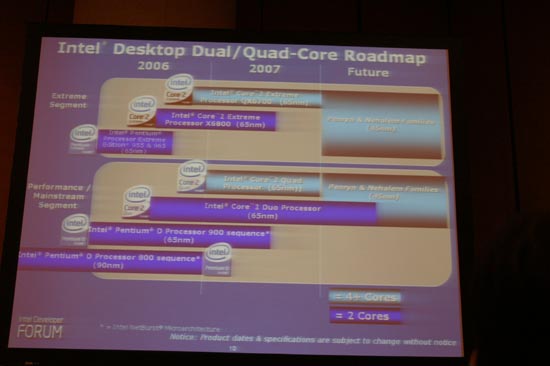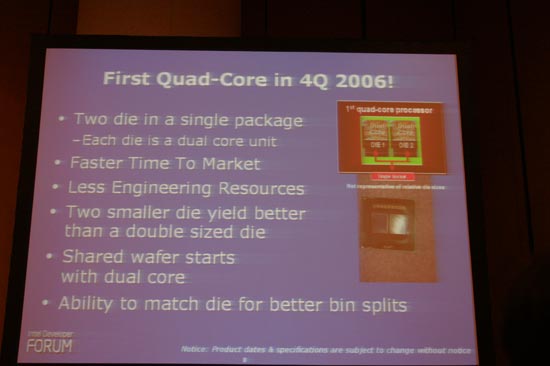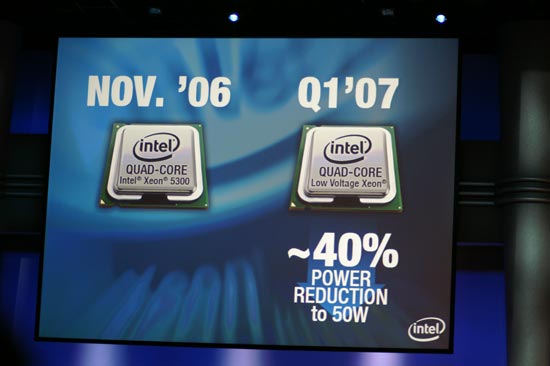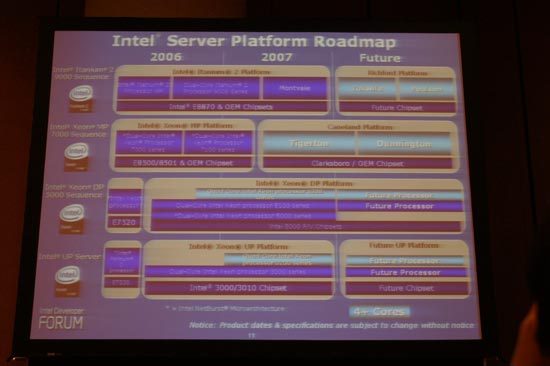Fall IDF 2006 - Day 1: 45/65nm, UMPC Update and Quad-Core
by Anand Shimpi & Larry Barber on September 26, 2006 5:03 PM EST- Posted in
- CPUs
Quad-Core in November
Intel's first quad-core processors will be released in Q4, and thus there's quite a bit of talk at IDF about Kenstfield (desktop) and Clovertown (server).

The first desktop quad-core processor will be the Core 2 Extreme QX6700 running at 2.66GHz, shipping in November of this year. Next year, Intel will introduce the Core 2 Quad Q6600 running at 2.40GHz. The transition to quad core CPUs will be much like the transition to dual-core CPUs in that for quite a while, the fastest processors will be offered in dual core flavors with slightly slower models available as quad-core.
Just like Intel's Presler processors, Kentsfield will actually feature two individual die on a single package (two dual-core processors on one package):

While having two independent dual-core die isn't as fast as a single integrated quad-core die, we expect the performance penalty to be minimal in most applications (just as it was with the first dual core Intel chips). There are some benefits to using two independent dual-core die on a single package, which are highlighted above. They mostly relate to manufacturing and optimizing costs/production and thus won't be directly visible to the end user. If history repeats itself, we should expect Penryn (45nm) to be Intel's first single die quad-core desktop processor.

On the server side, Intel will launch its quad-core Xeon 5300 series in November alongside Kentsfield on the desktop. The Xeon 5300 will also be composed of two dual core die on a single package, codenamed Clovertown. Even more interesting is the Low Voltage quad-core Xeon due out in Q1 '07 that will offer four cores in a 50W power envelope.

Next year Intel will also introduce its Caneland server platform for four socket servers, updating the Xeon MP platform to include support for Fully Buffered DIMM and four independent FSB interfaces - one for each socket.

While AMD's Direct Connect architecture is obviously a lot cleaner/simpler than requiring a MCH with four 64-bit FSB interfaces, until Intel eventually embraces an on-die MCH this is the best it can do. In order to help manage the CPU-to-CPU requests in the platform, Intel is also equipping the MCH with a 64MB Snoop Filter cache. Years ago Micron talked about equipping a chipset with an on-die L3 cache to help improve performance, and it's looking like Intel will be doing just that with its Caneland Xeon MP platform in Q3 '07.










12 Comments
View All Comments
GNStudios - Wednesday, September 27, 2006 - link
Is Quad-core going to much faster than dual-core, like when core 2 duo came?Reply is appriciated. :-)
Niv KA - Wednesday, September 27, 2006 - link
I have reasons to belive that whatever will come after Gesher will be very different from what we have today. Gesher is translated to brigde in Hebrew. Therefore I have reason to belive that what ever Gesher will be, it will be a transition to a new technology.I know I repeated myself a few times.
-- Niv K Aharonovich
sprockkets - Wednesday, September 27, 2006 - link
It used a Netburst and most likely a prescott core processor to operate WTF?GhandiInstinct - Wednesday, September 27, 2006 - link
The day, in a press conference, the day in which multi-code is mastered in software, that we see in a video game demo, a full fledged Torando tearing down a metropolis.yacoub - Tuesday, September 26, 2006 - link
Good coverage so far: Lots of pics, informative text between them, and lots of new tech incoming from Intel! wootporkster - Tuesday, September 26, 2006 - link
Any news on Santa Rosa chipsets? I couldn't see them in the road map.porkster - Tuesday, September 26, 2006 - link
Intel and Microsoft have no idea when it comes to what people will buy and can afford.Ye, like in the picture we are all going to buy 3 and 4 of these flop devices for our cars. Without these devices being under $200, no one will take then serious.
It seems like anytime someone bring up a portable, they have to use an expensive cpu in it. I can't see why you can't jsut echo a wifi'ed screen from another computer at home or in the car. A device the is a terminal, not a separate computer.
mino - Tuesday, September 26, 2006 - link
"Years ago Micron talked about equipping a chipset with an on-die L3 cache to help improve performance, and it's looking like Intel will be doing just that"IBM has it since 2002 ... ;)
BTW it was the main reason IMB did not jump on Opteron so eagerly. They have a chipset hugely hugely superior to Itel's Truland since 2003. Game over period.
That snoop cache is the thing which brought SC Nocona Xeons on par with SC Opterons in 4P-8P scenarios!!!
First Intel DC Smithfield _IS_ single-die, it is just glued together but single-die. The reason being MCM puts huge strain on FSB so they put an arbitter on a glued chip, to help achieve even mediocre 800FSB on their chipsets of the time.
mino - Tuesday, September 26, 2006 - link
"Years ago Micron talked about equipping a chipset with an on-die L3 cache to help improve performance, and it's looking like Intel will be doing just that"IBM has it since 2002 ... ;)
BTW it was the main reason IMB did not jump on Opteron so eagerly. They have a chipset hugely hugely superior to Itel's Truland since 2003. Game over period.
That snoop cache is the thing which brought SC Nocona Xeons on par with SC Opterons in 4P-8P scenarios!!!
BTW First Intel DC Smithfield _IS_ single-die, it is just glued together but single-die. The reason being MCM puts huge strain on FSB so they put an arbitter on a glued chip, to help achieve even mediocre 800FSB on their chipsets of the time.
mino - Tuesday, September 26, 2006 - link
screwed title, if posiible please delete/vote out. Thanks.